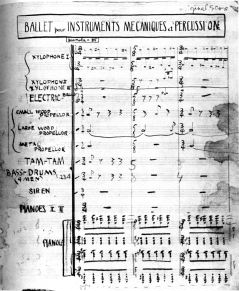Ballet Mécanique
General Info
Year: 1924
Duration: c.14:00 - 30:00; 18:00 (Siwe Catalog)
Difficulty: (see Ratings for explanation)
Publisher: Antheil; Schirmer
Cost: Score and Parts - $0.00 | Score Only - $0.00
Movements
Instrumentation
Player I:
Player II:
Errata
Program Notes
The Ballet mécanique is Antheil's most famous—or notorious—piece. At its various premieres, it caused tremendous controversy, not to mention fistfights. Although it was very successful in Paris, it was a huge flop when it came to New York, and in fact Antheil's career as a "serious" composer never recovered from that debacle.
The piece was originally supposed to be a soundtrack to a film of the same name by the French Dadaist painter Fernand Léger and cinematographer Dudley Murphy. But Antheil and the filmmakers worked separately from each other, and when they finally put the music and the film together, they realized they didn't work at all -- for one thing, the music was twice as long as the film. (A new version of the film, with—finally—Antheil's music, had its premiere on May 5, 2001)
The Ballet mécanique is a highly rhythmic, often brutalistic piece combining, among other elements, sounds of the industrial age, atonal music, and jazz. Its instrumental parts are extremely difficult to play, and it lasts, in its various versions, between 14 and 30 minutes.
Antheil wrote several versions of the piece. The very first, written in 1924 calls for 16 player pianos playing four separate parts, for four bass drums, three xylophones, a tam-tam, seven electric bells, a siren, and three different-sized airplane propellors (high wood, low wood, and metal), as well as two human-played pianos.
Until the 1990s, this version of the piece had never been performed in its original instrumentation, since the technology for linking and synchronizing multiple player pianos, whether 4 or 16, although theoretically possible when Antheil conceived the piece, turned out not to be practical. The European-based Ensemble Moderne was the first to attempt the piece: in 1996 and 1999, they performed it in Germany and France using two custom-modified MIDI-driven player pianos to play the 16 parts, and six pianists to play the two human parts.
In response to the technical difficulties, Antheil quickly re-arranged the piano parts, changing the orchestration to include unspecified multiple of two conventional pianos and a single player piano. This version was performed, using 10 human-played pianos, in Paris in 1926 and in an extremely ill-fated concert at New York's Carnegie Hall in 1927, where it created such a fiasco--technically, musically, and sociologically--that it was not performed again for over 60 years. In 1989 it was revived by conductor Maurice Peress for a performance at Carnegie Hall, and at that time received its first and only recording.
In 1953, after he had established himself as a film composer in Hollywood, Antheil again revised the piece, using a very different ensemble of four pianos, four xylophones, two electric bells, two propellors, timpani, glockenspiel, and assorted percussion. This version, which is much tighter and shorter than the early versions, is performed fairly often and has been recorded several times. Today, however, we have the technology to perform the piece with its original instrumentation. And it has now been done several times.
Awards
Commercial Discography
Recent Performances
To submit a performance please join the TEK Percussion Database
Works for Percussion by this Composer
Additional Resources
